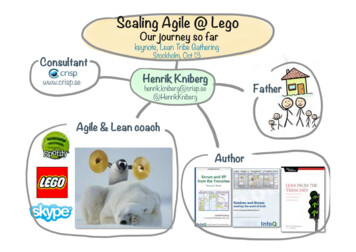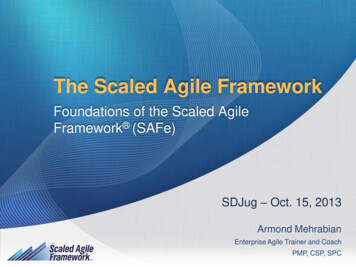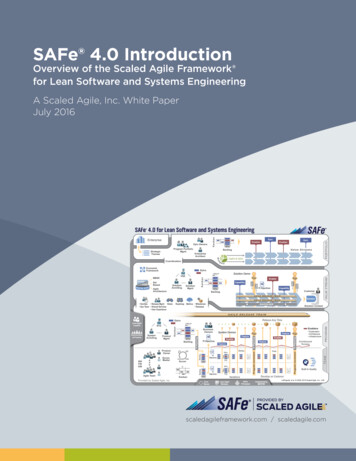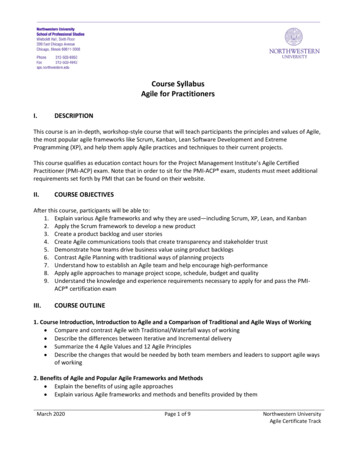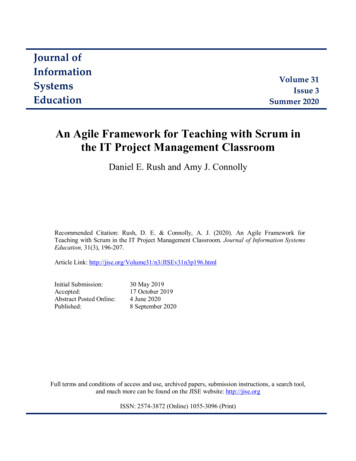
Transcription
Journal ofInformationSystemsEducationVolume 31Issue 3Summer 2020An Agile Framework for Teaching with Scrum inthe IT Project Management ClassroomDaniel E. Rush and Amy J. ConnollyRecommended Citation: Rush, D. E. & Connolly, A. J. (2020). An Agile Framework forTeaching with Scrum in the IT Project Management Classroom. Journal of Information SystemsEducation, 31(3), 196-207.Article Link: ial Submission:Accepted:Abstract Posted Online:Published:30 May 201917 October 20194 June 20208 September 2020Full terms and conditions of access and use, archived papers, submission instructions, a search tool,and much more can be found on the JISE website: http://jise.orgISSN: 2574-3872 (Online) 1055-3096 (Print)
Journal of Information Systems Education, Vol. 31(3) Summer 2020An Agile Framework for Teaching with Scrumin the IT Project Management ClassroomDaniel E. RushInformation Technology and Supply Chain ManagementBoise State UniversityBoise, ID 83725, USAdanrush@boisestate.eduAmy J. ConnollyComputer Information Systems and Business AnalyticsJames Madison UniversityHarrisonburg, VA 22807, USAconno3aj@jmu.eduABSTRACTThis paper presents a framework for teaching a complete, semester-long IT project management course with traditional PMI-basedcontent (sans software development) while featuring Scrum as the organizing logic for accomplishing coursework. This frameworkadapts widely-used Scrum practices from industry for use in the classroom, including how to organize student teams, homework,and activities. Organizing an existing course with Scrum is intended to maximize student learning of traditional project managementcontent, as well as the difficult-to-teach, socially-complex, “soft” skills that lead to Scrum team success. This deep integration ofScrum into a traditional, predictive IT project management course goes well beyond single activities or units without crowding outvaluable time and material. A brief overview of the agile philosophy and examples of teaching Scrum in the classroom situate thiswork in the teaching and learning literature. Classroom-tested Scrum rituals and example artifacts are provided to illustrate how toapply the framework. This group-based, iterative, and hands-on approach equips students to better internalize and understand thecomplex social interactions involved with a self-organizing team, concepts that are difficult to learn without first-hand experience.The proposed framework will help IS educators implement Scrum practices in their own courses, further addressing industry’sincreasing demand for IS professionals with Scrum experience.Keywords: Project management, Agile, Scrum, Pedagogy, Teaching framework, Active learning1. INTRODUCTIONThis paper presents a teaching framework for integrating Scrumin a traditional, predictive IT project management course. Thegoals of this framework are threefold: (1) to teach modern agileprinciples to upper division students with varying degrees ofproject experience independently from software development,(2) to teach traditional project management techniques andtools as embodied in the Project Management Institute’s (PMI)Project Management Body of Knowledge (PMBOK), and (3)for self-organizing student teams to develop important softskills (e.g., peer leadership, conflict resolution, andcommunication). Agile is arguably the most prevalentphilosophy for quickly and responsively developing software,and agile frameworks such as Scrum and eXtremeProgramming have gained significant adoption in softwaredevelopment curricula (Devedzic and Milenkovic, 2011;Mahnic, 2012; Lang, 2017). However, scant literature exploreshow to implement agile frameworks to teach projectmanagement to IS business students. In 2015, as the primaryauthor was preparing a project management course, he couldnot find examples of a course designed to meet all three goals.Since then, a small but growing body of pedagogical researchhas emerged with examples of teaching agile concepts in IS.However, none of these examples yet provides a tangibleframework for teaching a whole course in project management.As a result, this framework was built out of necessity and isshared here for other IS educators looking for a tested approach.The current literature suggests that when IS students learnabout agile concepts, it is in an introductory or limited fashion– as one topic among many, instead of internalizing the fullagile process. For example, students receive introductoryactivities or lessons that teach the “what” of agile withoutpracticing the “how” and “when” (e.g. Saade and Shah, 2016;Sibona, Pourreza, and Hill, 2018). While an introduction isnecessary and useful, Scrum involves much more, and one or196
Journal of Information Systems Education, Vol. 31(3) Summer 2020two exercises on agile are unlikely to provide students withsufficient group interaction to develop the social acumenneeded in industry (Baham, 2019).Agile focuses on individuals, collaboration, workingoutput, and adaptive response to change (Beck et al., 2001),meaning that soft skills (communication, collaboration, andflexible adaptation) are key to successful agile teams. Agileteams rely on communication to succeed (Hummel,Rosenkranz, and Holten, 2015). However, project managementcurricula has traditionally struggled to teach soft skills (Pantand Baroudi, 2008; Clarke, 2010) despite employers’ continueddemand for talent to communicate, adapt, and work effectivelyin project teams. A deeper engagement with agile experiencesin the IT project management classroom will help prepare ISstudents to meet this persistent demand for soft skills.To best realize the benefits of an agile framework such asScrum, students need to internalize the method in order to gainconfidence in their ability to use it in future work environments.One way to practice and internalize concepts is through activelearning. Active learning approaches have been shown toeffectively increase student performance (Freeman et al., 2014),and variations of active learning have long been present in theproject management classroom in one form or another (Allan,1999). Repetition and practice are hallmarks of active learningapproaches because they emphasize deep learning,understanding, and accountability (Lipman, 2003; Warburton,2003; Richmond, Boysen, and Gurung, 2016). We used anactive learning approach to build the framework for teachingthis course.This framework provided students with a breadth ofscenarios via classroom-based experiences. From theseexperiences, students developed confidence and demonstrableagile skills through repeated hands-on practice with Scrumrituals and artifacts. Learning through repeated practice is themethod advocated by industry experts to develop agile skills,whether through exposure to numerous case studies (Schwaber,2004) or through intense corporate training with group-based,iterative planning exercises (Griffiths, 2005). Therefore, ourmethod helps to further align IT project management curriculawith industry best practice.This paper describes the results of converting a 15-week,traditional IT project management course to a semester-longScrum project schedule with 2- to 3-week Sprints using Scrumroles, rituals, and artifacts to restructure the coverage of thecourse’s original project management content. Rather thanbolting-on a single lesson, activity, or module about the agilephilosophy or one of its associated frameworks, this hands-onScrum approach gives students months of experiencedeveloping their expertise in Scrum artifacts and the sociallycomplex rituals of Scrum, and in doing so, better prepares themfor agile projects.We anticipate this framework should be of use to anyonewho teaches or studies project management, especially today,as the field begins navigating how to complement training intraditional predictive approaches (e.g., SDLC and waterfall)with frequently-used agile approaches, without sacrificingcontent. The agile philosophy grew out of softwaredevelopment. Therefore, one challenge in implementing agilein the IT project management course is the lack of software orsystems development; students plan to build a project but theytypically do not actually build one. Our motivating question is:How can a college course in predictive IT project managementbe restructured without a software development component sothat students develop the skills to confidently work in agileScrum teams?This work contributes to the literature in informationsystems, IT project management, active learning pedagogy, andbeyond. To explain how we designed the framework andprovide valuable background context, we first review selectedliterature on agile and Scrum practices, focusing on therelationship of agile to traditional project management. We thendescribe how we structured a semester-long course to practiceagile project management principles while still teachingtraditional project management content. We describe the use ofhands-on exercises implementing the principles of agile andshow how the in-class exercises directly reflect industrypractice. We present preliminary lessons learned from teachingthe course twice, as well as student reflections. We concludewith reflections and possibilities for future research.2. LITERATURE REVIEW2.1 Agile in Teaching and LearningThe importance of incorporating the agile philosophy intoproject management curriculum is noted in the literature(Bredillet et al., 2013), however research on how to do this forIS and business students is still emerging. This is in directcontrast to teaching agile frameworks to software developers,of which there are many examples. For instance, Lang (2017)proposed “agile learning” in the context of a web appdevelopment course. Other software development examplesinclude McAvoy and Sammon (2005), Devedzic andMilenkovic (2011), and Mahnic (2012). However, withoutsoftware to develop, how does one provide opportunities forstudents to practice agile concepts on a project?Recently, a handful of IS pedagogy articles have shownhow to teach independent Scrum exercises in systems analysisand design (May, York, and Lending, 2016) and the Journal ofInformation Systems Education published a special issuededicated to teaching agile in IS. This issue explored methodsto teach either “What” agile is or “How” it can be implementedin a non-agile classroom (Sharp and Lang, 2018). Even so, themajority of the JISE special issue focused on programming orsystems analysis and design, courses which are more related tosoftware development rather than project management (Chenand Rea, 2018; Linden, 2018; Magana, Seah, and Thomas,2018; Taipalus, Seppänen, and Pirhonen, 2018). The JISEspecial issue included two papers with examples of using agilein project management or a general MIS course (rather thansoftware development), but even these had only one or twobroad lessons but no examples of how to teach agile or Scrumin the rest of the course (Schmitz, 2018; Sibona, Pourreza, andHill, 2018). In order to teach students the socially-complexnature of agile teams, teams must be given sufficient time tonorm and perform, processes that take time (Tuckman andJensen, 1977).Other than two recent conference presentations (Javadi andTanner, 2018; Owens and Shekhar, 2018), the most similarwork we could identify to this one reported on a Master’s levelagile project management class in which the entire course wasconverted to a Scrum-like, Sprint-based structure (Cubric,2013). In that course, the class replaced software developmentwith wiki edits and recorded what they learned about agile197
Journal of Information Systems Education, Vol. 31(3) Summer 2020project management in a collaboratively-produced artifact. Theresults indicated that increased communication and Sprintplanning contributed to group cohesion and that teamwork,negotiation, and mutual respect were all significantly enhanced.The framework presented in the present paper provides similarteam results, but in an undergraduate course and withdeliverables and team activities that students are more likely toencounter in a general industry setting (e.g., project charters,Gantt charts, earned value spreadsheets, and teampresentations) as opposed to Wiki pages. To the best of ourknowledge, our paper is among the first to present a frameworkfor teaching Scrum all semester in the IT project managementcourse, without having students design software. Although webelieve there are examples of IS instructors using agile forproject management, these are not readily available for use.2.2 What is Agile Project Management?The agile philosophy encompasses any method that supportsthe Agile Manifesto’s values of “Individuals and interactionsover processes and tools, Working software overcomprehensive documentation, Customer collaboration overcontract negotiation, and Responding to change over followinga plan” (Beck, et al., 2001). Agile frameworks dominatesoftware development and include methods such as Crystal,Dynamic Software Development Method, feature-drivendevelopment, Lean software development, Scrum, Extremeprogramming (XP, XP2), and variations such as “Scrumban”which combine Scrum and Kanban techniques (Dybå andDingsøyr, 2008; Stettina and Hörz, 2015). Since the Manifestowas declared by software developers in 2001, this philosophyhas expanded to other areas of business, such as service delivery(Kowalkowski et al., 2012), general business processes (Graml,Bracht, and Spies, 2008), and business intelligence (Larson andChang, 2016).The widespread adoption of these techniques and theirimportance to project management are reinforced in the latestrevision of the PMI’s PMBOK Guide (2017a), which for thefirst time came bundled with a companion book, “The AgilePractice Guide” (2017c) recognizing agile’s growing place inproject management. In project management, agile issometimes contrasted with predictive waterfall methods;however, they are not orthogonal. In fact, companies can anddo manage projects in a hybrid manner, mixing these methods,depending on the size, type, and needs of the project (West etal., 2011). Multiple examples of mixed-methods approachesfrom companies such as Caterpillar, Blue Cross Blue Shield ofNebraska, IBM, and City Furniture are relayed in the PMI’sPulse of the Profession report, “Achieving Greater Agility”(PMI, 2017b). The theme of the report emphasizes that deliveryapproaches are selected based on the organization’s needs andproject characteristics, that PMO functions such as minimizingrisk and controlling costs are still required for agile projects,and that project managers should be adaptable and well versedin agile and predictive approaches.2.3 Scrum MethodologyScrum is one of the most popular of the agile methods and is aprocess model of project management because it specifies aprocess that is performed iteratively until a business ownerdeclares the output complete. Scrum relies on small teams ofpractitioners who self-govern and organize themselves usingthe processes prescribed by Scrum (Schwaber, 2004). One ofScrum’s central tenets – and the hardest to learn – is how toeffectively operate in a self-organizing team (Kropp et al.,2014). Thus, Scrum instruction that aspires beyond theintroductory level should challenge students to engage deeplyand repeatedly in a variety of team-based interactions that occurwhile practicing Scrum rituals. These interactions guidestudents to develop experience and social competence in selforganizing. As Kropp et al. (2014) discuss, the agilecompetencies most in need of being developed go beyondengineering principles and management practices. From alearning theory standpoint, these social competencies are on ahigher level than technical skills alone.Effective student learning of these skills occurs whenstudents “[develop] and [discuss] agile values and attitudes”(Kropp et al. 2014, p. 144), which is achieved when studentsgain “personal experience socially through realisticdiscourse” (Kropp et al., 2014, p. 143). We organized ourinstruction to develop this socially-complex set ofcompetencies by creating opportunities for students to engagein realistic discourse. We believe this structure is recognizableas Scrum while striking a balance between giving studentsenough freedom to find their own answers and a clear enoughstructure to feel confident in their learning. We next describethe classroom site and how Scrum was integrated into thecurricula, both in general terms and with concrete examples.3. COURSE SETTING3.1 Classroom SiteThis teaching framework was implemented across two years ofan upper-division IT Project Management (“ITPM”) class at amid-size teaching university in the western United States.Offered each spring, the class serves as an elective for businessfocused computer information systems (CIS) students and as arequired course for software engineering (SE) students. As aresult of this compositional mix, students begin the courseeither familiar with software development but with minimalexperience in business fundamentals (e.g., time value of money,people management, and presentation skills) or vice-versa.Regardless of background, the course provides students withthe opportunity to learn the breadth of project managementconcepts and their connections to business fundamentals,independent of software development.3.2 Supporting Textbook and ProjectsThe project management course content before and aftermodification was based on the PMI’s PMBOK Guide, 5th ed(2013). For the two semesters described, Kathy Schwalbe’s ITProject Management, 8th edition (2016) was adopted, which isstructured generally by PMI Knowledge Areas (KA) andProcess Groups (PG). The course also included three ofSchwalbe’s “running cases” which are simulated ITimplementation projects. For example, the cases cover projectswherein students organize a global entrepreneurial event orestimate the costs of implementing energy-efficient hardwareupgrades in various companies. These cases include specificdeliverables and activities aligned with each of the PMI KA’sand PG’s. Team deliverables from these cases were projectartifacts such as a business case, project management plan,Gantt chart, etc. Running cases are commonly used in IT projectmanagement to simulate the concepts of completing a project(Austin, Nolan, and O’Donnell, 2009). In addition to team198
Journal of Information Systems Education, Vol. 31(3) Summer 2020SprintPre-Sprint (PS)Sprint 1 (S1)Exam 1 (E1)Sprint 2 (S2)Sprint 3 (S3)Exam 2 (E2R, E2)Sprint 4 (S4)Sprint 5 (S5)Sprint 6 (S6)Final Exam (E3)M/W/F, 6-Sprint Topic AreasHow class works, Agile (SCRUM) in theclassroom, Intro to PM, MS ProjectPM in the IT Context, MS Project, PM ProcessGroupsOne class-period examProject Integration Management, Project ScopeManagementProject Time Management, Project CostManagement, Facilitated Sprint 3 Retrospective inSession 24Review one day, Exam the nextProject Quality Management, Project HumanResource ManagementProject Communications Management, ProjectRisk ManagementProject Procurement Management, ProjectStakeholder ManagementExtended time-period examT/Th, 5-Sprint Topic AreasHow class works, Agile (SCRUM) in theclassroom, Intro to PMPM in the IT Context, MS Project, PM ProcessGroups, Project Integration ManagementOne class-period examProject Scope Management, Project TimeManagement (1st half)Project Time Management (2nd half), Project CostManagement, Project Stakeholder Management,Project Communications ManagementOne class-period examProject Human Resource Management, ProjectQuality ManagementProject Risk Management, Project ProcurementManagementN/AReview in Session 30, Extended time-period examduring finals weekTable 1. Topic and Sprint Schedules for 15-Week Semestersdeliverables, students completed individual quizzes and examsand a number of individual assignments. The approximatedistribution of work was 60% individual (15% participation,15% quizzes, and 30% exams) and 40% team (Sprinthomework). A list of topics covered in the course is presentedby Sprint for both 2- and 3-day-a-week meeting schedules inTable 1.In the pilot semester, the course met 3 days a week onMonday/Wednesday/Friday for 50-minute class periods. In thesecond iteration, the course met on a Tuesday/Thursdayschedule for 75-minute class periods which affected the numberof in-class Scrum meetings that were possible. The morefrequent meetings of the 3-day-a-week schedule felt moreSprint-like, but the Sprint review sessions were less compressedin the 2-day-a-week schedule due to an extra 25 minutes perclass session.4. COURSE STRUCTURE4.1 Non-Scrum Classroom TimeOne of the benefits to this framework is that the Scrum activitiesdescribed in the following sections complement rather thanmonopolize instructional contact time. Much of the timededicated to Scrum activities is spent discussing or reviewingtraditional project management content in teams or as a class,and after all activities are accounted for, approximately 60% ofthe contact hours remain unaffected and available for nonScrum instruction (such as lectures), activities, and individualassessment. While Sprint planning and Sprint review meetingstake up much (or all) of the class meetings in which they occur,during the remaining class sessions the Daily Scrum meetingwas the only time dedicated to Scrum. After the Scrum meetingconcluded, the remaining time was spent with mini-lectures,discussions of book topics, exercises to practice concepts, etc.We found the time for these activities sufficient to engage withall the traditional project management content covered by acourse that did not adopt the Scrum structure.4.2 Semester ScheduleThe course was taught during a 15-week semester with a oneweek, mid-semester break. In addition to the team-based workon the running case studies and other Schwalbe homework, twomid-semester exams and a final exam were administered afterthe first, third, and last Sprint. These exams and an associatedreview session were outside of (between) Sprints and weredesigned to assess individual understanding of the PMBOKmaterial.4.3 Scrum Training and Team FormationThe semester started with a short pre-Sprint period in whichstudents learned the agile philosophy and Scrum concepts. Theuse of Scrum teams was introduced in the first class, with anassigned reading from Schwalbe and the Scrum Reference Card(James, 2012). The readings were followed by a lecture onScrum, with example Scrum videos and artifacts shown in classand available on the course Learning Management System(LMS). The introduction to Scrum in the pre-Sprint period wassimilar to the individual activities or lessons recently reportedin the literature (e.g., May, York, and Lending, 2016; Sibona,Pourreza, and Hill, 2018). What differentiates our frameworkfrom these excellent introductions is the repeated practice ofScrum rituals throughout the course, rather than moving on tonon-agile topics after the agile lectures and activities. This newmethod provided teams with more opportunities to develop andpractice self-governance and other critical “soft” skills. Again,what’s new here is the opportunity for students to “close theloop” to see how the entire Scrum process works and to makechanges to how they execute the process over the length of thesemester.The instructor assigned teams based on students’availability to meet outside of class, along with major, year-inprogram, and other considerations to ensure a mix of experience199
Journal of Information Systems Education, Vol. 31(3) Summer 2020and ability on each team. In the second semester, students wereasked to participate in a collective decision making process todevelop and adopt a set of rules for group discussions. Theserules were brainstormed in the first class meeting and a subsetwas adopted in the next class meeting.4.4 Five 2-to-3 Week SprintsThe 15-week semester was divided into approximately 2-weekScrum Sprints (6 in the pilot semester and 5 in the secondsemester due to days of instruction (TR versus MWF)), with aninitial one-to-two weeks for Scrum training and team formationplus time for semester exams and final exam review. Duringeach Sprint, students chose, committed to, worked on, andpresented the results of homework assignments from the bookor a running case. Each Sprint lasted four to six class sessions.We next describe the details of Sprint structures and howwe adapted industry practice to a classroom setting. We thensupplement this description with concrete examples fromSprint 5 in the second iteration of the class to show how itworked. Additionally, the idealized industry experience andwhat was happening in the classroom were emphasized tostudents as part of their learning in the first few Sprints, to makethese experiences seem more realistic.5. USING THE SCRUM METHOD TO TEACHIT PROJECT MANAGEMENT5.1 Scrum DescriptionIn the ITPM classroom, we implemented a version of Scrumcontaining widely used roles, standardized meetings (‘rituals’),and artifacts, examples of which are shown in Table 2, adaptedfrom Schwaber (2004). These core Scrum roles and ritualsprepare students for organizations with customized Scrumimplementations (e.g., Business Analyst or other areas ofexpertise instead of a generic “Team Member” role).Scrum meetings scaffold selecting work, monitoringprogress, confirming acceptance of the final deliverables, andimproving the work processes. In the ITPM classroom, thisScrum RolesProduct Owner, ScrumMaster,Team MemberScrum RitualsSprint Planning Meeting, DailyScrum Meeting, Sprint ReviewMeeting, Sprint RetrospectiveMeetingScrum ArtifactProduct Backlog, Sprint Backlog,ExamplesTask Board, Sprint BurndownChartTable 2. Sprint Roles, Rituals, and Example Artifactsrepetition provided a structure and cadence for each Sprint.Students internalized this pattern through repeated practice overthe semester, allowing their knowledge of Scrum to move from“what it is” to “how we produce work with it.”A figure of a typical Sprint iteration is shown in Figure 1(adapted from James 2012). To work in an educational setting,this general pattern was adapted from industry and supportedwith Scrum artifacts and rituals, which we instantiated in theclassroom. A description of how each Scrum component mightbe generally used in an industry setting can be readily found inmaterials such as the PMI publication “The Agile PracticeGuide” (2017c) or Schwaber’s book Agile Project Managementwith Scrum (2004). We adapted these rituals to the classroom,as explained in the next section.5.2 Scrum Applied in the ClassroomAdapting Scrum to the classroom consisted of altering presemester preparation activities and adapting the in-classschedule to accommodate Scrum activities. The followingsections describe how each Sprint ritual or artifact was adaptedfor the classroom, after which concrete examples drawn from asingle Sprint in the second iteration are shown.Figure 1. Typical Sprint Process (adapted from James, 2012)200
Journal of Information Systems Education, Vol. 31(3) Summer 20205.2.1 Preparation prior to Sprint. Prior to assigning work tothe Scrum teams, the instructor first developed the assignmentsand organized them into backlog items. In contrast to the userstories common in industry, classroom PBIs were assignmentsfrom the book or tasks associated with a running case. Theseassignments covered the KAs and PGs taught near the Sprint inwhich the tasks were assigned. These tasks showcased how theinstructor adapted industry practices for the classroom.5.2.2 ScrumMaster and Sprint planning meeting. At thebeginning of each Sprint, the student teams elected aScrumMaster. Each team member was required to serve asScrumMaster at least once during the semester, to give everystudent an opportunity to practice that role’s responsibilities:coordinating the team’s efforts, resolving blocking issues, andreporting on the progress of deliverables. After selecting aScrumMaster, the team held a Sprint planning meeting with theproduct owner (the instructor) to review and prioritize PBIs inthe product backlog. Attendance at this meeting wasmandatory. The team selected how many PBIs they estimatedthey could complete during the Sprint. The team was thencommitted to these PBIs for the duration of the Sprint. Finally,as the last part of the Sprint planning meeting, the team dividedeach PBI into Sprint tasks, estimated the amount of effortrequired to complete the tasks, and assigned each task to aresponsible person. These tasks formed the committed Sprintbacklog (the output of the Sprint planning meeting). TheScrumMaster then represented the team’s backlog in a visuallyaccessible manner on a Kanban board (an example is providedin section 5.3.2) for the team to reference and update duringdaily Scrum meetings.The instructor provided a force ranked list wherein eachPBI was given an importance priority (from 1 to 8, with 1 beingthe highest) and a point value (from 5 to 25 in 5-pointincrements). The point values were not equivalent to functionpoints used in software development complexity, but theyserved as a guide for students to estimate the amount of workper deliverable. The point values represented the maximumpossible grade for a successfully completed deliverable.Students could elect as a team to attempt any number of PBIs,although the maximum total points for each Sprint was cappedat a specific total points possible. In theory, a team that did notattempt enough PBIs might earn less than 100% homeworkgrade, but generally teams chose enough PBIs for the possiblepoint total to meet or exceed the cap (the latter to earn themaximum allowable credit for the Sprint, even if they did notearn full points on all the PBIs).The student teams used the in-class planning meeting toselect PBIs and obtain instructor clarification on expectations,akin to a project meeting with a customer. During thesemeetings, the instructor clarified course concepts associatedwith PBI deliverables
An Agile Framework for Teaching with Scrum in the IT Project Management Classroom. Daniel E. Rush and Amy J. Connolly . Recommended Citation: Rush, D. E. & Connolly, A. J. (2020). An Agile Framework for Teaching with Scrum in the IT Project Management Classroom. Journal of Inf


